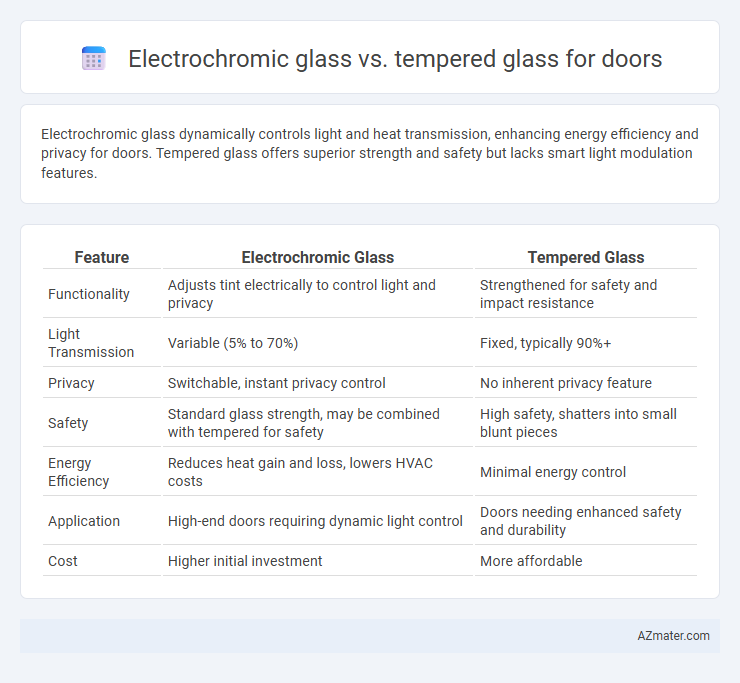Electrochromic glass dynamically controls light and heat transmission, enhancing energy efficiency and privacy for doors. Tempered glass offers superior strength and safety but lacks smart light modulation features.
Table of Comparison
| Feature | Electrochromic Glass | Tempered Glass |
|---|---|---|
| Functionality | Adjusts tint electrically to control light and privacy | Strengthened for safety and impact resistance |
| Light Transmission | Variable (5% to 70%) | Fixed, typically 90%+ |
| Privacy | Switchable, instant privacy control | No inherent privacy feature |
| Safety | Standard glass strength, may be combined with tempered for safety | High safety, shatters into small blunt pieces |
| Energy Efficiency | Reduces heat gain and loss, lowers HVAC costs | Minimal energy control |
| Application | High-end doors requiring dynamic light control | Doors needing enhanced safety and durability |
| Cost | Higher initial investment | More affordable |
Introduction to Electrochromic Glass and Tempered Glass
Electrochromic glass features a smart technology that allows it to change transparency when an electric voltage is applied, offering dynamic control over light and heat transmission for doors in modern buildings. Tempered glass is a type of safety glass processed by controlled thermal or chemical treatments to increase strength, designed to shatter into small, blunt pieces upon impact to reduce injury risk. The choice between electrochromic glass and tempered glass depends on the desired functionality, with electrochromic glass providing energy efficiency and privacy, while tempered glass ensures enhanced safety and durability.
Key Differences Between Electrochromic and Tempered Glass
Electrochromic glass offers dynamic light control by changing opacity through an electrical current, optimizing privacy and energy efficiency, while tempered glass is known for its high strength and safety, shattering into small, non-sharp pieces when broken. Electrochromic glass incorporates smart technology suitable for modern, energy-efficient doors, whereas tempered glass is favored for durable, impact-resistant door applications. Key differences include functionality, with electrochromic glass providing adjustable tinting, and tempered glass providing enhanced physical strength without altering transparency.
How Electrochromic Glass Works in Doors
Electrochromic glass in doors operates by applying a low-voltage electrical current to change the glass's opacity, allowing users to switch from transparent to opaque for privacy and light control. Unlike tempered glass, which is designed primarily for safety and impact resistance, electrochromic glass offers dynamic shading without blocking views or natural light when clear. This technology enhances energy efficiency by reducing glare and heat transmission, making it ideal for smart door applications.
Tempered Glass: Strength and Safety Features
Tempered glass offers superior strength compared to electrochromic glass, as it is heat-treated to be approximately four to five times stronger than standard glass, making it highly resistant to impact and thermal stress. Its safety features include shattering into small, blunt pieces upon breakage, significantly reducing the risk of injury in high-traffic door applications. These properties make tempered glass an ideal choice for doors requiring enhanced durability, security, and compliance with building safety codes.
Aesthetics and Design Flexibility
Electrochromic glass offers dynamic tinting capabilities that enhance door aesthetics by allowing seamless light control and privacy without compromising transparency, providing superior design flexibility for modern interiors. Tempered glass, while highly durable and safe, has fixed transparency and limited aesthetic variation, constraining creative design options. Choosing electrochromic glass enables architects and designers to integrate adaptive visual elements, complementing contemporary styles and optimizing natural light management in door applications.
Energy Efficiency Comparison
Electrochromic glass enhances energy efficiency by dynamically adjusting its tint to reduce solar heat gain and glare, significantly lowering cooling costs compared to traditional tempered glass. Tempered glass, while strong and safety-compliant, does not offer variable shading, leading to higher reliance on HVAC systems for temperature control. Installing electrochromic glass in doors optimizes natural light management and reduces energy consumption through smart, adaptive insulation properties.
Privacy Control and Light Modulation
Electrochromic glass offers dynamic privacy control and adjustable light modulation by changing from transparent to opaque with an electric signal, allowing users to customize visibility and natural light intake instantly. Tempered glass, while highly durable and impact-resistant, provides no inherent privacy or light modulation features, remaining consistently transparent. This makes electrochromic glass a superior choice for doors where privacy and variable daylight management are critical.
Installation and Maintenance Requirements
Electrochromic glass requires professional installation due to its integration with electronic components, including wiring for voltage control to switch transparency levels, which can increase complexity compared to tempered glass. Tempered glass offers straightforward installation as standard door glass, supported by its durability and shatter resistance without needing electrical connections. Maintenance for electrochromic glass involves specialized care for electronic systems and potential software updates, while tempered glass demands minimal upkeep, primarily regular cleaning and inspection for physical damage.
Cost Implications for Door Applications
Electrochromic glass for door applications involves higher upfront costs compared to tempered glass due to advanced technology and installation complexity, with prices ranging from $50 to $100 per square foot versus $15 to $30 for tempered glass. Maintenance and energy savings from electrochromic glass can reduce long-term expenses through automated light and heat control, potentially offsetting initial investments over time. Tempered glass remains a cost-effective option for basic durability and safety, but lacks electrochromic benefits that enhance energy efficiency and user comfort.
Choosing the Right Glass Type for Your Door
Electrochromic glass offers dynamic light control and privacy by changing transparency with an electric signal, making it ideal for modern, energy-efficient doors. Tempered glass, known for its superior strength and safety due to heat treatment, provides durability and shatter resistance perfect for high-traffic or security-focused door installations. Choosing between these depends on whether you prioritize smart functionality or robust safety features for your door.

Infographic: Electrochromic glass vs Tempered glass for Door
 azmater.com
azmater.com